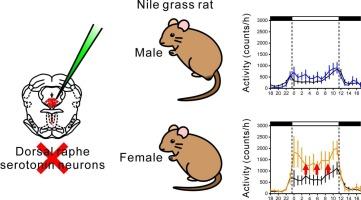Sex differences in serotonergic control of daytime activities in diurnal Nile grass rats
IF 2.6
4区 医学
Q3 NEUROSCIENCES
引用次数: 0
Abstract
The mechanisms underlying day-active behaviors in diurnal species are still unclear. We lesioned midbrain serotonergic neurons and monitored the effect on spontaneous locomotor activity in diurnal Nile grass rats. First, serotonergic neuron localization was visualized by tryptophan hydroxylase 2 immunofluorescence staining. Using this position on the brain map of Nile grass rat, dorsal raphe nucleus (DRN) lesions were produced by microinjection of an adeno-associated virus (AAV) carrying diphtheria toxin-fragment A (DTA) or the serotonergic neuron toxin 5,7-dihydroxytryptamine (5,7-DHT). Spontaneous locomotor rhythms were monitored for 1 week following a recovery period. The 5,7-DHT lesions destroyed approximately 90 % of tryptophan hydroxylase 2-positive neurons in the DRN and chronically increased daytime activity in female Nile grass rats. The results are independent of estrous cycles because estrous cycles were paused in this species under male-isolated recording environments. AAV-DTA lesions, which were driven by nonspecific CMV-Cre, partially (<60 %) destroyed DRN serotonergic neurons but failed to modulate activity levels. Additionally, neither 5,7-DHT nor AAV-DTA modulated night-time activities. Interestingly, 5,7-DHT produced the same damage in DRN serotonergic neurons in male Nile grass rats but had little effect on their activity. Furthermore, the depression index, determined by a tail suspension test, was not modulated by DRN lesions regardless of the lesion method or sex of Nile grass rats. Previous studies showed that diurnal activity in Nile grass rats is highly dependent on light intensity. Thus, disinhibition of photic inputs by DRN lesions may be a plausible mechanism, although the underlying mechanisms require further investigation.

尼罗河草鼠血清素能控制日间活动的性别差异
昼行动物日间活动行为的机制尚不清楚。对尼罗草大鼠中脑血清素能神经元进行损伤,观察其对自发性运动活动的影响。首先,色氨酸羟化酶2免疫荧光染色显示血清素能神经元的定位。利用尼罗草大鼠脑图上的这个位置,通过微量注射携带白喉毒素片段A (DTA)或5 -羟色胺能神经元毒素5,7-二羟色胺(5,7- dht)的腺相关病毒(AAV)产生中音背核(DRN)病变。恢复期后1周监测自发运动节律。5,7- dht损伤破坏了DRN中约90%的色氨酸羟化酶2阳性神经元,并使雌性尼罗河草大鼠的日间活动长期增加。结果与发情周期无关,因为在雄性隔离的记录环境下,该物种的发情周期暂停。AAV-DTA病变由非特异性CMV-Cre驱动,部分(60%)破坏DRN 5 -羟色胺能神经元,但无法调节活性水平。此外,5,7- dht和AAV-DTA都不能调节夜间活动。有趣的是,5,7- dht对雄性尼罗草大鼠的DRN - 5 -羟色胺能神经元产生相同的损伤,但对其活性几乎没有影响。此外,通过悬尾试验确定的抑郁指数不受尼罗草大鼠DRN病变的影响,无论病变方式或性别如何。先前的研究表明,尼罗河草鼠的昼夜活动高度依赖于光强。因此,DRN损伤对光输入的去抑制可能是一种合理的机制,尽管潜在的机制需要进一步研究。
本文章由计算机程序翻译,如有差异,请以英文原文为准。
求助全文
约1分钟内获得全文
求助全文
来源期刊

Brain Research
医学-神经科学
CiteScore
5.90
自引率
3.40%
发文量
268
审稿时长
47 days
期刊介绍:
An international multidisciplinary journal devoted to fundamental research in the brain sciences.
Brain Research publishes papers reporting interdisciplinary investigations of nervous system structure and function that are of general interest to the international community of neuroscientists. As is evident from the journals name, its scope is broad, ranging from cellular and molecular studies through systems neuroscience, cognition and disease. Invited reviews are also published; suggestions for and inquiries about potential reviews are welcomed.
With the appearance of the final issue of the 2011 subscription, Vol. 67/1-2 (24 June 2011), Brain Research Reviews has ceased publication as a distinct journal separate from Brain Research. Review articles accepted for Brain Research are now published in that journal.
 求助内容:
求助内容: 应助结果提醒方式:
应助结果提醒方式:


